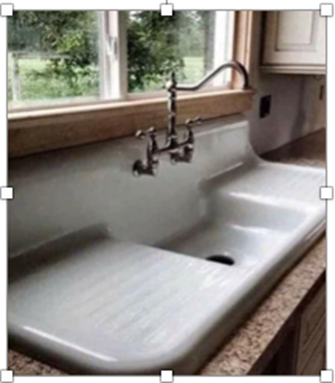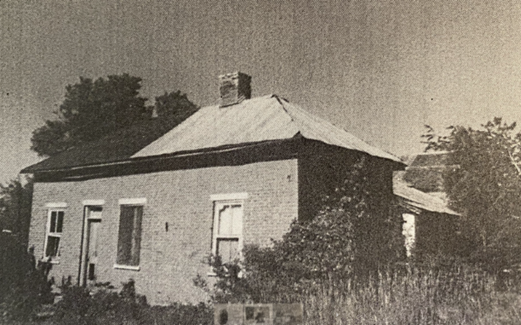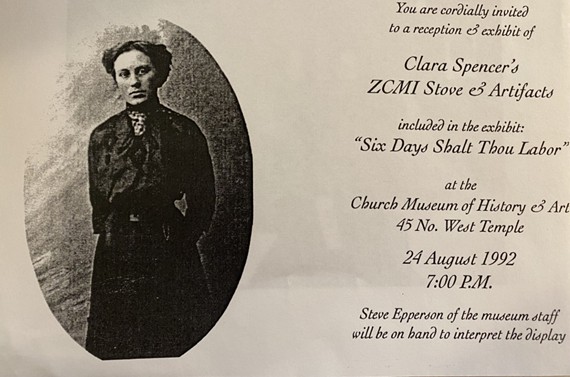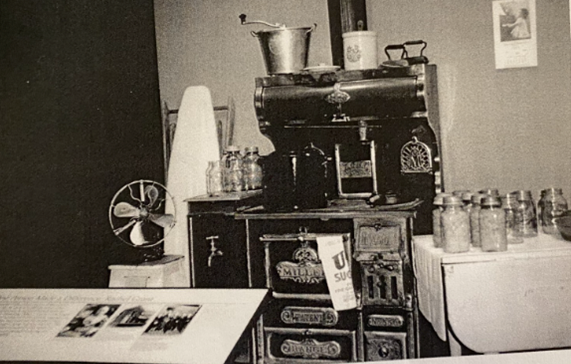“The era we’re reconstructing first had kitchen sinks fabricated from sheet copper with a hole in the bottom, that frequently drained to the outside. 40 or so years later the fashion was a cast iron sink with flanges that integrated into a tile counter top, and between those styles there was a cast iron sink with rounded edges that set on top of the work surface. That’s the version we’re looking for … and here it is!”
With that, two workers from the Mormon Church History Museum (CHM) grabbed the sink from the back of my truck, spirited up two floors to the reconstruction of Clara’s kitchen, followed by the director and several curators, and installed it in the counter top. Didn’t even bother to clean it. The grand opening was the next day, with a VIP tour that very evening.
This story actually begins in 1895 with the death of Lorenzo Dow Young (1807 – 1895) Brigham’s younger brother and one of the original 1847 Utah pioneers. One of his granddaughters, Persis Ann Brown (1855 -1919) took her inheritance and bought a pump organ (still in the family somewhere), four bent wood chairs (I still use them), and an all-metal wood/coal burning stove with a 15 gallon copper holding tank. You know the Saturday night bath stories. That stove was probably the equivalent of the first color TV in town. Wow ! Oh, and a new-fangled cast iron sink.

When Persis Ann Brown passed away, my grandmother Clara Esplin Spencer (1839 – 1971) inherited her house. Clara was widowed in 1933 and left with 8 children. The oldest was 17 and the youngest 7 months.
When Clara passed, my wife, Suzanne, and I drove from Vail to Kanab to rescue the stove, since no one wanted it, and the house was falling down around it.

A decade or so went by. We retrieved the stove from a friend’s barn and put it in the unfinished basement of our new home in Farmington. We had given up on our hippie dream of a cabin in the woods. With the encouragement of Mom (Persis Spencer Carling 1919 – 2011), I started looking for a home for the stove.
The Daughters of the Utah Pioneers (D.U.P.) wasn’t even remotely interested, but Suzanne was REAL interested in getting it out of our basement. I couldn’t even think of selling it. Finally, someone from the CHM expressed a mild interest. After seeing what good condition it was in they wanted it. The transfer was completed, and a small display was put together in the basement of the museum. The stove was then sent to a warehouse somewhere, and we didn’t hear any more about it for several years.
One day, Mom called and said that the Church was going to do a permanent (year or more) display entitled Women & Work, and it was going to take up most of the second floor of the Church Museum, and they were going to make the stove a center piece, and they wanted to reconstruct Clara’s kitchen, “and a curator/designer is on her way over to talk to me!”
The curator said that when she started to put the Women & Work project together, she was walking through the church warehouse one day and “The stove practically spoke to me.”
We (mostly Persis) pulled out all the stops. She got her engineer brothers to make dimensioned scale drawings of the kitchen and all of its all contents. Siblings contributed bits of old linoleum that were used as patterns for the floor. Pieces of the lace curtains from the kitchen window were found and used as samples for beautiful new curtains. A stool and the aforementioned bent wood chairs were loaned. All was well. The only piece missing was the kitchen sink.
Since the opening was 18 months away, and with all the personnel and financial resources of the Church, everyone was certain the correct sink could be located.
Turns out there are plumbing fixture graveyards, and the curator and I did a couple of field trips turning over mountains of porcelain and cast iron treasures, never even coming close to what we wanted. There was a happy news flash once that someone had located “The perfect sink” in a closet in Nauvoo. We waited with the proverbial “bated breath” for the package to arrive, only to find out it was a janitor’s sink you could buy anywhere.
As time was getting short, I volunteered to help build the kitchen set. Just showed up and went to work., all gratis of course.
Well, now it’s two days until opening. I’m at Mom’s apartment, and she says forcefully “What’s a kitchen without a sink!”
“Wow, I agree Mom, what can I do?”
“You go down to the DUP in the morning and tell them that you have to locate that sink.”
Of course I did, and of course they gave me the “blank look.” Someone in the office said, “You might try the Utah History Archives.” Ok, another goose chase, but I’m on a mission from Mom.
Go to the archives, and pretty much the same story, except as I was leaving a lady at a desk in back said that an old two-story house in the Avenues was being remodeled and they put plumbing fixtures for sale out on their lawn sometimes.
Off to the address she gave me, to a neat old two-story, dusty, rose brick building of the type they built about the turn of the century. Knock on the door. There’s a hole in the jamb where a bell is supposed to be. No answer. I go around to the back, and there are stacks of windows, doors, and a rather interesting looking sink. Square corners where it could fit into a tile counter top. Could be right? I dunno, but I’m on a mission etc. So I load it into my truck. Pretty sure that’s stealing, but I’m on a mission etc.
Feeling a little guilty, I go around to the front door and try again to raise the owner. This time I’m successful. Explaining my “mission” and that I already took one sink, did he happen to have any more? Turned out to be a great guy. We went back to “the pile,” where he dug out a cast iron sink with rounded edges that would sit on top of the work surface. It was complete with the original faucets and drain pipe, so we loaded that in too. Somehow I felt that could be the one. “Bring back any you can’t use. They’re $15 each.”
The Museum was only a few blocks from there, and just on a hunch I drove up to the “RESTRICTED” parking gate and told the person on the other end that “I have a kitchen sink .” The gate opened immediately, and four or five guys, some in suits, were waiting for me when I backed up to the dock. The guy who said the little speech at the beginning of this story grabbed that round shouldered sink and was gone in a heartbeat.
By now it was after noon, and I didn’t feel much like putting on my nail belt. President Leonard, director of the Museum, asked me if I’d like to come to the private V.I.P. opening that night, and would I like to bring my wife? “Here’s an invitation, just show it at the door.” Suzanne framed the program, and it still hangs on our wall.



It was pretty special, but not as special as Mom & her siblings standing in the public opening of their mother’s kitchen, put together by the church she and her family worked and sacrificed for. My sister, Barbara, took this picture at the opening, and used it for my mother’s obituary. If you look closely you’ll see the sink and the faucets in the background. After all, what’s a kitchen without a sink!


Love this story, Duane! One of my favorites! Women’s work: six days shalt though labor… Humph! You know the saying… A woman’s work is never done.
This is an interesting and well written story Duane. Thank you for sharing this view of your life with all of us.
I remember visiting your grandmother’s home in Kanab and my parents saying it dated back to the pioneer era. This was such a fun story. Your mom was a great scratch cook. I loved her pies, etc. Thanks for sharing!